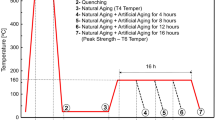Abstract
A high-performance, high-strength, and novel AI-Zn-Mg-Cu alloy in the T7751 condition was deformed to failure in laboratory air environment at ambient and elevated temperatures. Temperature influenced the tensile response of the alloy for both the longitudinal and transverse orientations. Strength decreased with an increase in test temperature, with a concomitant improvement in ductility. Test results indicate the alloy response to be the same for both the longitudinal and transverse orientations. No major change in the macroscopic fracture mode was observed with the direction of testing. Tensile fracture, on a microscopic scale, revealed features reminiscent of both ductile and brittle mechanisms. The microscopic fracture behavior was a function of test temperature. The mechanisms and intrinsic micromechanisms governing the tensile fracture process are discussed in terms of mutually interactive influences of microstructural effects, matrix deformation characteristics, test temperature, and grain boundary failure.
Similar content being viewed by others
References
J.G. Kaufman, “Design of Aluminum Alloys for High Toughness and High Fatigue Strength,” 40th Meeting of Structures and Materials Panel, (Brussels, Belgium), NATO, April 1975
R.E. Sanders, Jr. and E.A. Starke, Jr., Metall. Trans. A, Vol 6, 1978,p1087
M.V. Hyatt and W.E. Quist, AFML Technical Report, TR-67-329, 1967
E.A. Starke, Jr. and W.E. Quist, in Flight Vehicle Materials, Structures and Dynamics: Assessment and Future Directions, Vol 2, A.K. Noor and S.L. Venneri, Ed., American Society of Mechanical Engineers, 1992, p 118–160
J.T. Staley, Technical Report, Contract M00019-71-C-0131, Naval Air Systems Command, May 1972
J.T. Staley, “Microstructure and Toughness of High Strength Aluminum Alloys,” presented at ASTM Symposium on Properties as Related to Toughness, (Montreal, Canada), ASTM, June 1975
J.S. Santner, AFML Technical Report, TR-76-200, March 1977
F. Ostermann, Metall. Trans., Vol 2,1971, p 2897–2902
E. DiRusso, M. Conserva, F. Gatto, and H. Markus, Metall. Trans.,Vol 4, 1973, p 1133–1144
W.H. Reimann and A.W. Brisbane, Eng. Fract. Mech., Vol 5, 1973, p 67–78
D.S. Thompson, S.A. Levy, and D.K. Benson, Thermomechanical Aging of Aluminum Alloys, Third International Conference on Strength of Metals and Alloys, Cambridge University Press, England, 1973, p 119–123
J.E. Vruggink, Technical Report, 76073, Frankford-Arsenal, April 1977
H. Sulinski and J. Waldman, Summary Report, Frankford-Arsenal, July 1976
J.T. Staley and R.L. Rolf, International Symposium on Light Metals, The Minerals, Metals and Materials Society, August 1993
J.T. Staley, Aluminum Alloys and Composites, Encyclopedia of Physical Science, Elsevier Applied Science, NY, Vol 1, 1992, p 591–598
E.A. Starke, Jr., Mater. Sei. Eng., Vol 29, 1977, p 99–112
E. Hornbogen and E.A. Starke, Jr., Acta Metall. Mater., Vol 41 (No. 1), 1993, p 1–16
L.F. Mondolfo, N.A. Gjoestein, and P.W. Levinson, Trans. AIME, Vol 206,1956, p 1311
J.T. Staley, Metall. Trans. A, Vol 5, 1974, p 929–940
“Tension Testing of Metallic Materials,” E-8-93, ASTM, 1993
S. Anand, “The Cyclic Fatigue and Fracture Behavior of Two High Strength Al-Zn-Mg-Cu Alloys,” Master of Science thesis, University of Akron, 1992
R.E. Crooks and E.A. Starke, Jr., Metall. Trans. A, Vol 15, 1984, pl367
J.P. Hirth and J. Lothe, Theory of Dislocations, McGraw Hill, 1968, p 694
N.F. Mott, Proc. R. Soc. A, Vol 200,1953, p 1
A.H. Stroh, Proc. R. Soc. A, Vol 223,1954, p 404
J.M. Duva, M.A. Daubler, E.A. Starke, Jr., and G. Lutjering, Acta Metall.,Vol36,1988, p 585
J. Gurland and J. Plateau, Trans. ASM, Vol 56,1963, p 442
R.H. Van Stone and J.A. Psioda, Metall. Trans. A, Vol 6,1975, p 672
A.S. Argon, J. Im, and A. Needleman, Metall. Trans. A, Vol 6, 1975,p825
A.S. Argon, J. Eng. Mater. Techno!., Vol 98, 1976, p 60
Author information
Authors and Affiliations
Rights and permissions
About this article
Cite this article
Srivatsan, T.S., Anand, S., Veeraghavan, D. et al. The tensile response and fracture behavior of an Al-Zn-Mg-Cu alloy: Influence of temperature. J. of Materi Eng and Perform 6, 349–358 (1997). https://doi.org/10.1007/s11665-997-0100-6
Issue Date:
DOI: https://doi.org/10.1007/s11665-997-0100-6




